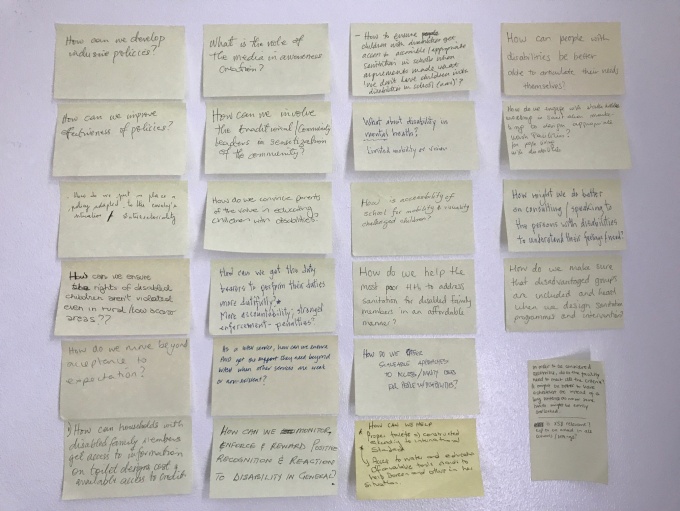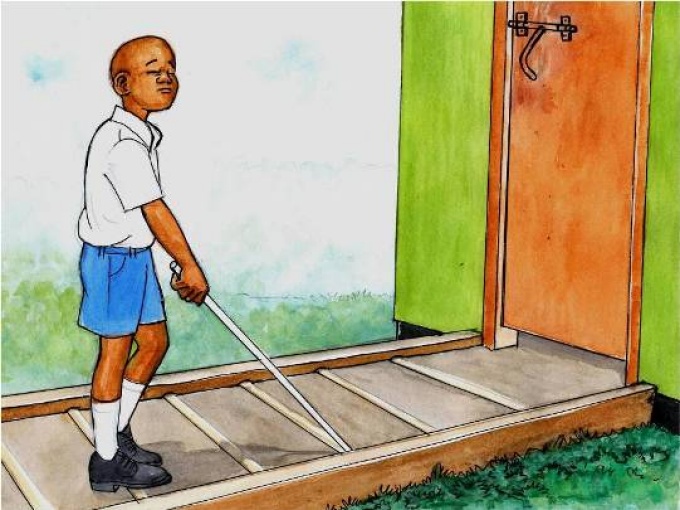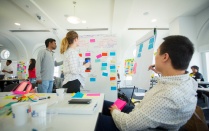Monitoring Inclusive WaSH in Schools
Harnessing SDG4 to Improve the Lives of Children with Disabilities
Worldwide, 800 million people with disabilities live in low- and middle-income countries. Designing safe, accessible, and usable water, sanitation, and hygiene (WaSH) facilities is a critical imperative – not only important for ensuring public health but also for promoting equal access to education, employment, and social services.
In Uganda, for example, 94% of children with disabilities do not complete primary school; unsafe and inaccessible WaSH facilities are one contributing factor. The University at Buffalo is partnering with the UNICEF/WHO Joint Monitoring Programme, as well as WaterAid and ATC Uganda, to build knowledge, capacity, and tools on accessible WaSH facilities in schools. This partnership led to the first global monitoring instrument, Core Questions and Indicators for Monitoring WASH in Schools in the Sustainable Development Goals, launched in 2016. The session held at WEDC 2017 provided training and solicited feedback on this work.
2017 WEDC Powerpoint Presentation
Our Collaborators

Ashabrick Nantege
Coordinator
Appropriate Technology Centre (Uganda)

Louisa Gosling
Quality Programmes Manager
WaterAid (United Kingdom)
Founding Co-Lead, Community for Global Health Equity; Professor and Chair
Department of Architecture
Phone: 716-575-2874
Email: khsmith@

Tom SLaymaker
Senior Statistics and Monitoring Specialist (WaSH)
UNICEF (United States)
Special thanks to University at Buffalo students Gauri Desai, Nabila Ismail, and Carl Reeves, for assisting with this research. Their work was funded in part by HealthyWorld Foundation and The Randwood Foundation.
Follow-Up Document to the WEDC Side Event, 24 July 2017, Loughborough University, UK
Sponsored by the University at Buffalo – State University of New York, USA

The side event on WaSH in schools explored challenges and potential solutions to support the education of children with disabilities (CWDs). Thirty participants represented an array of geographies, organizations, and disciplines/sectors. Presentations during the session discussed: (1) a human rights approach to WaSH, (2) specific challenges of WaSH in Ugandan schools, (3) the new JMP indicators for WaSH in schools, and (4) data collected in 27 Ugandan schools using the new indicators for accessibility (see attached PowerPoint file). The table below provides a summary of the issues and challenges that participants, themselves, identified, as well as a few interesting ideas/possible solutions that arose. Challenge areas that emerged during the session included: data, policies, resources, capacity, attitudes, facilities, and management. The organizers have also included a preliminary list of resources aligned with the challenges that participants identified.

Above: a sample of “How to…?” questions posed by participants during the interactive session.
| Challenges | Allied Issues | Interesting Ideas/Possible Solutions | Sample Resources |
Data: How might data regarding disability prevalence, policies, norms, and WaSH facilities be improved? | diverse definitions of disability (country to country)
lack of data on disability prevalence
lack of comprehensive disability policy database
lack of data on accessible WaSH facilities in schools | WaterAid, UNICEF, and the WHO are currently working to harmonize definitions and data collection on both disability and WaSH for disability. Active, national surveillance systems can complement this effort. | Disability and Culture Download pdf, Ingstad, 1995
WHO World Report and Disability, 2011
Water supply and sanitation access and use by physically disabled people Download pdf, Jones, Parker, & Reed, 2002
|
Policies: How might policies supporting the rights of people with disabilities be developed across sectors? | lack of provisions on accessible WaSH in schools
overemphasis on one type of disability (e.g., mobility)
lack of awareness of rights and self-advocacy among PWDs
lack of prioritization of policies | In Cambodia (and elsewhere) acquired disabilities are viewed differently than disabilities from birth onward. A two-phased approach to policy development might be: (1) develop inclusive policies for acquired disabilities, then (2) normalize disability for inclusive policies for at-birth disabilities. | Indonesian education system: Influencing policy to achieve results Download pdf, Isradi Alireja, 2008
Policy and provision of WASH in schools for children with disabilities: A case study in Malawi and Uganda, Erhard, Degabriele, Naughton, & Freeman, 2013 |
Resources: How might multi-sector, multi-scale resources be leveraged to support inclusive WaSH in schools? | lack of funding aligned with policies
reliance on charitable organizations rather than mainstream business | Convincing funders to support both business-led models and enforcement for inclusive WaSH in schools could complement the work of advocacy and capacity building. | Water supply and sanitation access and use by physically disabled people, Download pdf Jones et al., 2002
Inclusive design of school latrines: how much does it cost and who benefits? Jones, H. (2011) WEDC Briefing Note #1. |
Capacity: How might capacity be improved across sectors and at multiple scales? | lack of engagement of WaSH sector with people with disabilities (PWDs)
lack of knowledge among architects, planners, and engineers on accessible design
lack of training for teachers on assisting CWDs
lack of occupational/rehabilitation training for CWDs | What responsibilities reside with schools? What roles might families and communities play? How might individuals be empowered toward self-advocacy? In addition to building capacity across education, health, and WaSH sectors, schools might play a role not only in educating students but also in educating communities about disability--helping, on behalf of families, to normalize disability in the community and empower people to speak up. | Mainstreaming disability and ageing in water and sanitation programs Download pdf, Jones, 2013
Including persons with disabilities in water sector operations: Guidance note by the World Bank |
Attitudes: How might cultural attitudes and behaviors toward disability be changed? | disability seen as a stigma
disability as perceived/actual burden to caregivers
lack of understanding of the diverse lived experiences of disability by family members, community, and WaSH sector
stereotyping of disability (e.g., belief that disability diminishes educational ability, employability, etc.)
intersectional challenges: disability + gender + rural/urban
isolation of PWDs hides prevalence of disability from public view | Following the London Olympics, the Paralympics of 2012 used the branding "meet the superhumans." Athletics, the arts, academics, or other competitive venues might provide a way of demonstrating the capabilities of people across disability groups. | Disability in cross-cultural perspective: rethinking disability Download pdf, Groce, 1999
Disability and Culture Download pdf, Coleridge, 2000 |
Facilities: How might the design and construction of WaSH facilities be improved to support children with disabilities? | poor infrastructure (e.g., transportation) to support access to schools
facilities designed from "able-bodied-male" perspective, not from a diverse-population perspective
poorly designed individual features (e.g., toilets, taps, etc.)
lack of continuity/connection between features (e.g., classroom to path to toilet to wash basin) | International WaSH NGOs vary greatly in size. Larger organizations, such as WaterAid, can work with smaller organizations to design and construct exemplary inclusive WaSH facilities that can be replicated. The design process can include members of the disability community to provide feedback on proposed solutions and prototypes. | Water, Sanitation and Hygiene Standards for Schools in Low-cost Settings Download pdf, Adams, 2009
Inclusive design of school latrines - how much does it cost and who benefits? Download pdf WEDC, 2011
Learning materials on equity and inclusion in WASH from WEDC |
Management: How might the management of WaSH facilities in schools be improved? | lack of understanding of role that maintenance plays in supporting equitable access
poor leadership at school
insufficient maintenance plan/budget | Some schools have partially accessible facilities (e.g., some classrooms are more accessible than others). Schools could develop flexible mechanisms for accommodating both permanent and temporary disabilities (e.g., a child with a broken leg), such assigning teachers or classrooms most capable of supporting specific students. | Core questions and indicators for monitoring WASH in Schools in the Sustainable Development Goals, WHO/UNICEF, 2016
Inclusive education: An EFA strategy for all children, Peters, 2004
Accessibility and safety audit for school latrines Download doc |

Tactile strips and an upstand on a path to a toilet (Tanzania), Susana Secretariat, 2011, Modified


